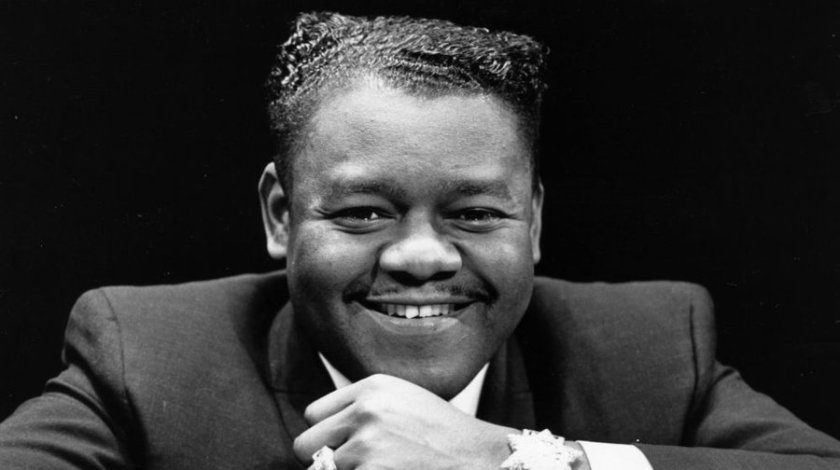
While many of rock and roll’s pioneers have continued to record and tour, it wasn’t the case for Antoine Dominique Domino Jr., known worldwide as ‘Fats’. In the early ’90s he’d decided that he’d had enough of touring, and the legendary singer-pianist chose to remain in his hometown of New Orleans in the years that followed. This may be why the news of his loss this past week at age 89 seemed a little muted, as it had been so long since he’d been in the musical spotlight. Still, it didn’t take any time at all for people to recognize just how strong an impact his recordings had on the direction of popular music.
Mr. Domino was born and raised in New Orleans – and he was playing piano in bars by the age of 14! His nickname came from comparisons to Fats Waller and Fats Pichon – although his eating habits at the time apparently played a role, too. By 1949 he started his recording career with “The Fat Man”, which went on to hit #2 on the R&B charts – and in the process, unintentionally helped along the creation of rock and roll.
Three years later, he broke into the pop top-40 for the first time with “Goin’ Home” – and it would take an additional three years before he made the top-10, thanks to a number he co-wrote with Dave Bartholomew, “Ain’t That A Shame”.
Unfortunately, it would be Pat Boone’s more mainstream version that got to #1 on the pop charts – an achievement not granted to Fats’ recordings. Still the tune would take on a life of its own over the decades, thanks to covers by such stars as the Four Seasons, Hank Wiliams Jr., Tanya Tucker, Brownsville Station, Cheap Trick, and separate takes by John Lennon (as it was the first song John had learned to play) and Paul McCartney.
1956 brought even bigger success Fats’ way, thanks to such hits as “Blue Monday” (another frequently covered tune that Dave wrote) and the double-sided single “I’m In Love Again” and “My Blue Heaven”.
The tune that would become most associated with Mr. Domino was also released that year: “Blueberry Hill”, a #2 pop hit and #1 R&B smash that was actually a cover of a 1940’s Gene Autry recording!
1957 brought along yet another landmark collaboration with Dave Bartholomew, in the form of “I’m Walkin'” (which would also jumpstart the singing career of teenager Ricky Nelson later that year, thanks to a cover version).
Fats continued to cross over regularly with such hits as 1958’s “Whole Lotta Lovin'” and 1959’s “I Want To Walk You Home”, with “I’m Gonna Be A Wheel Someday” as the latter’s B-side.
He got to pay tribute to his hometown in his final big hit, 1960’s “Walking To New Orleans”, backed by another of his songs with a heavy Crescent City influence, “My Girl Josephine”.
Fats Domino continued to record throughout the 1960’s, but a change both in record labels and popular music styles kept him from having any further big hits. Still, over the years he was frequently recognized for his musical contributions – including being part of the very first class inducted into the Rock And Roll Hall Of Fame in 1986. He also received the Grammy Lifetime Achievement Award the following year, and the National Medal of Arts from President Bill Clinton in 1998. (He also became the inspiration for the name that Dick Clark’s wife gave to singer Ernest Evans: Chubby Checker!)
Just before Hurricane Katrina hit New Orleans in 2005, Fats chose not to evacuate – but after his home was damaged from the subsequent flooding, he was rescued by a Coast Guard helicopter and brought to safety. Despite losing much of what he owned, he was eventually able to return to his restored home, and even personally received a replacement medal from President George W. Bush. For the next few years he put in occasional appearances at concerts and other public events, and even made a cameo on HBO’s “Treme”. His final recordings from the 1990’s were released as a benefit album for area musicians, while some of rock music’s top names paid tribute to him on the album “Goin’ Home”, which helped to restore Fats’ hurricane-damaged publishing office.
Fats was often considered to be among the nicest stars in the music business, and he was among the first to bring elements of New Orleans culture into the mainstream. There’s also no doubt as to how much he shaped the early years of rock and roll. There may have been many who followed and learned from his musical and personal examples, but it’s just as clear that there will only be one Fats Domino.

